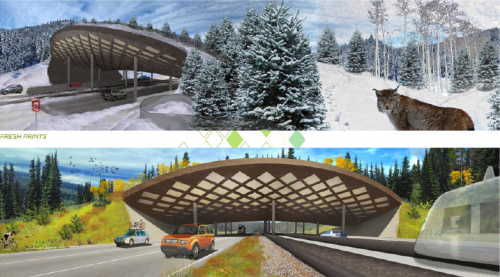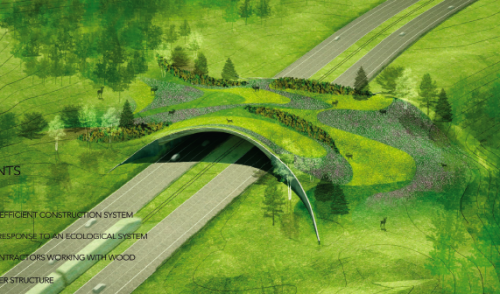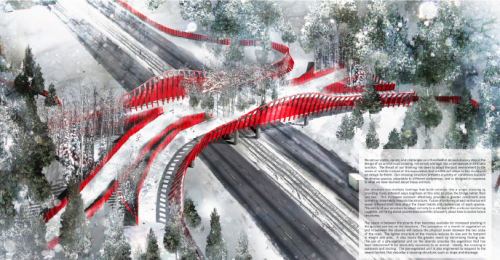It is with pure Colorado pride that I share some of the winning entries to ARC Wildlife Crossing design competition.

Colorado is a complicated state — you can begin to tell that if you watch any election — it is decidedly a swinger. But the varigated nature runs a bit deeper than red or blue implies. It is full of contradictions, lots of people who love to be outdoors and who appreciate all the natural beauty. Some are naturalist conservationist types, and others are games-people hunter types, but most interestingly — many are both. This type of blurring across lines of this side and that side are common there. It’s like a whole state full of Teddy Roosevelts and it makes me proud, that in a sea of midwestern conservative predictability, there can exist a place where, despite a media pull to make everthing seem black and white, alot of people still think in various shades of grey. It seems a perfect site for this type of project to get built.

I have driven I-70 across the Rockies probably hundreds (thousands?) of times in my life…I even thought I might die a time or two on that highway…I think most Coloradans can make the same claim. Whether it is crazy weather, or some other freak of nature happening (avalanche, mountain top electrical storm, animal encounter, out of control semi truck bearing down on you, etc. etc.), even just a drive to the mountains can be an adventure. Animals and wildlife are an ever present part of this equation, so taking them into consideration – as a main consideration – in the building of a bridge is genius. The ARC competition is about just that — providing a way for wildlife to cross the highway that man cut through the wild. Specifically, near Vail — where crazy highway crap always seems to happen.

If you think about it — it seems almost surprising that wildlife bridges aren’t a more common part of roadway planning. My mind tends to go to the extreme and I imagine the road going in, and the momma bear getting stuck on one side — her cubs on the other. (oh if only roads could be built that fast!!)
But the reality is not that far off….migratory patterns are interupted, populations of animals are split up and divided for breeding purposes and probably a whole host of other effects are felt that we aren’t even fully aware of. Same goes for the land that you might be using to create a garden. Have you thought about how to peacefully co-exist with the animals in your neighborhood? I know it can be hard – especially when a woodchuck keeps eating everything in sight. But it is worth thinking about because, more often than not, it is easier to work with them, than against them. And not only were they there first, but fighting them can often cause more harm than good.
I am curious, how have you incorporated wildlife into you garden design?
Apparently the funding for the construction of the bridge is not sitting happily in some municipal bond….but I am hopeful that by spreading an interest in the project and encouraging a groundswell of public support, perhaps this can change. (Perhaps you can contribute to that by tweeting this post, or the link to the ARC website, maybe facebook it , or social media it in whatever way you play).
Love it…lived in Colorado for years and think it’s a great idea.
I used to live in west vail where this bridge is proposed. I can attest that it is a wildlife crossing hotspot. Many things have been tried to ameliorate the problem. Sturdy fences to prevent animals from getting on the highway are frequently breeched. One way gates to allow animals to exit the highway if they do get on, require some learning before they are used. It seems the tunnel installed in Eaglevail was never used. I would hope that this very expensive solution would work better.
Having studied landscape architecture and later env. science / environmental legislation, I know this is NOT a new concept, but it gets rediscovered every generation. It would be so wonderful if people would stop talking about them and start BUILDING them. The only bad points about them are getting funding. It will take another John Muir and “Standing for the Trees” to make it happen.
btw, I appreciate your musings.